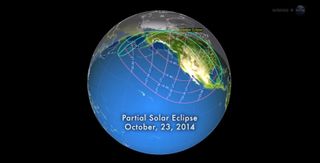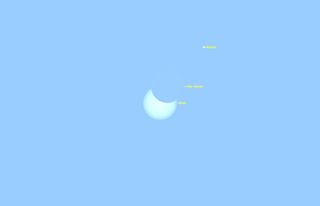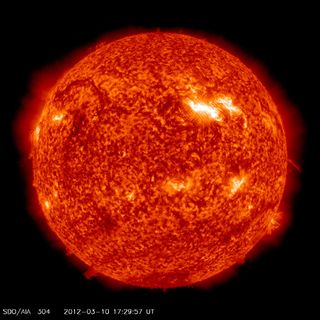
Mark Thursday (Oct. 23) on your calendar as "Solar Eclipse Day," for if the weather cooperates, you should have no difficulty observing a partial eclipse of the sun.
Nearly all of North America, except for a portion of eastern Canada and a slice of eastern New England, will experience the partial solar eclipse this week. People who live east of a line running from roughly Quebec City to Montauk Point, New York, will miss out on the solar show, since the sun will set before the dark disc of the moon begins to encroach upon it.
The several hundred thousand people who inhabit parts of Siberia will get a brief view around local sunrise time — but on Friday (Oct. 24), because this part of the eclipse visibility zone is to the west of the International Date Line. So, for this part of the world, the event will begin on the day after it ends! [Partial Solar Eclipse of October 2014: Visibility Maps]
The rest of North America will see less of the sun covered.
For much of Alaska, western and central Canada, the Pacific Northwest and the northern Plains, more than 60 percent of the sun's diameter will be covered by the passing new moon. For the Southwest and central and southern Plains, the eclipse magnitude diminishes to between 40 and 60 percent. Across the Ohio, Tennessee and Mississippi valleys, maximum eclipse will coincide with sunset, while farther to the east, the moon will only begin its encroachment onto the sun's disc as it sets.
In the United States, more than half of the sun's diameter will be covered north of a line extending from San Francisco to the Oklahoma panhandle. But this will occur in the mid- to late-afternoon hours — too late to dim the landscape abnormally. Some people might still attempt to record the gradual fading and recovery of the sunlight with sensitive photographic exposure meters. These can be set to view a light-colored wall that faces toward the Southwest.
Get the Space.com Newsletter
Breaking space news, the latest updates on rocket launches, skywatching events and more!
Be careful!
Unlike a total eclipse of the sun, which concentrates viewing excitement into a few fleeting minutes, a partial solar eclipse can be watched without urgency.
Observations can be made with the naked eye, binoculars or telescopes of any size. Of course, eyes and instruments must be protected by special filters from the intense light and heat of the focused solar rays. Keep in mind that the sun is no less dangerous to look at during a partial eclipse than it is on a normal sunny day. Don't be tempted to squint at the spectacle or steal unsafe glances just because part of the sun's surface is blocked by the moon! [How to Safely Observe the Sun (Infographic)]
During the eclipse, drawings and photographs can be made to show the moon's progress across the solar disc. If your camera is capable of taking multiple exposures through a wide-angle lens, the whole phenomenon might be captured on a composite scene, but a telephoto lens is necessary if you're trying to bring out the jagged profile of the lunar limb. The moon may temporarily hide some sunspots.
At locations where sunset occurs before the end of partial eclipse, some unusual pictures might be obtained, especially if horizon conditions favor the occurrence of the atmospheric phenomenon known as the green flash on the sun's upper rim.
But again, be careful! Only attempt such observations if you have the proper solar filters. If you don't have them, don't watch the eclipse directly, either with the naked eye or through binoculars or a telescope — serious and permanent eye damage will likely result.
Pinhole eclipses

People who aren't expecting the event will probably not notice it, although some might see the peculiar shape of "pinhole" images of the sun cast by trees and bushes. Indoors, closed Venetian blinds in a southwest-facing window may produce rows of such images, where sunlight passes through small openings.
Also, a small hole pierced in a dark shade will cast a sizable eclipse image onto a wall, floor or screen. Thus, even a person confined indoors can watch this celestial phenomenon.
Local circumstances and eclipse times for the United States can be found here: http://eclipse.gsfc.nasa.gov/OH/OHtables/OH2014-Tab05.pdf
And information for a number of cities in Canada and Mexico is listed here:
http://eclipse.gsfc.nasa.gov/OH/OHtables/OH2014-Tab04.pdf
These data are courtesy of eclipse expert Fred Espenak, who works at NASA's Goddard Space Flight Center in Maryland.

A warm-up for 2017
While Thursday's solar eclipse will be exciting, some skywatchers in North America are already looking ahead three years.
On Aug. 21, 2017, the first total eclipse of the sun to be visible from the contiguous 48 states in nearly four decades will sweep in an east-southeast direction from Oregon to South Carolina. So, for many, Oct. 23 will provide a rehearsal for the big event of 2017.
Although it lacks many phenomena that occur during a total eclipse, a partial one nonetheless provides an excellent opportunity to try out instruments and procedures.
Editor's Note: If you take an amazing skywatching photo of the partial solar eclipse or any other celestial sight that you'd like to share for a possible story or image gallery, please contact managing editor Tariq Malik at spacephotos@space.com.
Joe Rao serves as an instructor and guest lecturer at New York's Hayden Planetarium. He writes about astronomy for Natural History magazine, the Farmer's Almanac and other publications, and he is also an on-camera meteorologist for News 12 Westchester, New York. Follow us @Spacedotcom, Facebook or Google+. Originally published on Space.com.
Join our Space Forums to keep talking space on the latest missions, night sky and more! And if you have a news tip, correction or comment, let us know at: community@space.com.

Joe Rao is Space.com's skywatching columnist, as well as a veteran meteorologist and eclipse chaser who also serves as an instructor and guest lecturer at New York's Hayden Planetarium. He writes about astronomy for Natural History magazine, the Farmers' Almanac and other publications. Joe is an 8-time Emmy-nominated meteorologist who served the Putnam Valley region of New York for over 21 years. You can find him on Twitter and YouTube tracking lunar and solar eclipses, meteor showers and more. To find out Joe's latest project, visit him on Twitter.
